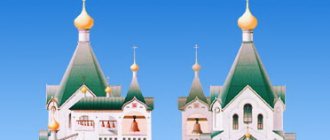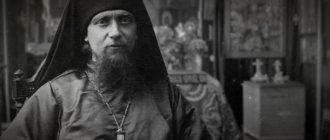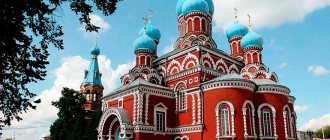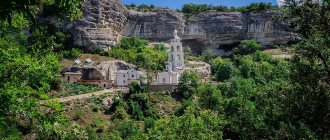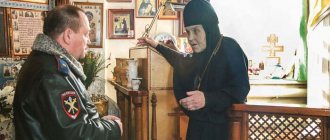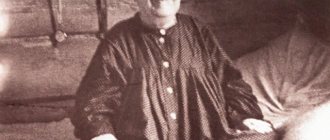| Cathedral of Tula Saints |
The Council of Tula Saints
is a holiday of the Russian Orthodox Church in honor of the saints who shone in the Tula land. Celebrated on September 22
The celebration of the cathedral memory of all the saints who shone in the land of Tula was established on June 3, 1987 on the initiative of Archbishop of Tula and Belevsky Maxim (Krokha). The day of celebration was timed to coincide with the day of memory of St. Macarius of Zhabynsky and Belevsky.
The Tula Council is one of the most numerous in the Russian Orthodox Church, it includes more than 30 Russian saints, more than 20 holy princes and princesses, more than 30 saints, several holy fools for Christ. Since the Kulikovo field is located within the Tula diocese, when the celebration was established, the names of the ascetics and martyrs associated with the Battle of Kulikovo were also included in the cathedral memory.
To establish the names of all the ascetics who were directly related to the Tula land, a lot of research work was done under the leadership of Archbishop of Tula and Belevsky Maxim. Archbishop Maxim composed a service for the Council of Tula Saints, and a special icon was painted for the day of celebration. At the top of it is the Kazan Icon of the Mother of God - a shrine of the city of Tula, supported by an Angel, to the right and left - St. Nicholas the Wonderworker and St. Macarius of Zhabynsky. Below is the All Saints Cathedral, which is surrounded by images of the saints of the Tula land.
The Cathedral of Tula Saints includes:
- St. Nicholas of Myra, archbishop, wonderworker, participant in the First Ecumenical Council: (+345-351, commemorated May 9, July 29, December 6)
- Blgv. Boris, passion-bearer, prince (+ 1015, commemorated May 2, July 24)
- Blgv. Gleb, passion-bearer, prince: (+ 1015, commemorated May 2, July 24, September 5)
- Sschmch. Kuksha Pechersky, hierome, enlightener of the Vyatichi, in the Near (Antoniev) caves (+ after 1114, commemorated August 27)
- Mch. Nikon Pechersky, student of the martyr. Kuksha of Pechersk (+ after 1114, commemorated on August 27)
- St. Theoktist of Pechersk, Chernigov, bishop, in the Near (Antoniev) caves (+ 1123, commemorated August 5)
- St. Nikola Svyatosha, Chernigov, Pechersk, prince, monk, wonderworker, in the Near (Antoniev) caves (+ 1143, commemorated October 14)
- Blgv. Igor Olgovich, Chernigov and Kiev, led. prince, wonderworker (+ 1147, commemorated June 5, September 19)
- Mch. Mikhail Vsevolodovich, Chernigov, prince, wonderworker (+ 1245, commemorated February 14, September 20)
- Blgv. Alexander Nevsky, lead. prince (+ 1263, commemorated August 30, November 23)
- Blgv. led book John Kalita (+ 1340, commemorated March 31)
- St. Alexander Peresvet, warrior, schema. (+ 1380, commemorated September 7)
- St. Andrey Oslyabya, warrior, schema. (+ 1380, commemorated September 7)
- Blgv. Dimitry Donskoy, leader. prince (+ 1389, commemorated May 19)
- St. Pimen (Black), archbishop. Novgorod (+ 1571, commemorated September 25)
- St. Macarius Zhabynsky, Belevsky, Hieroschim. (+ 1623, memory January 22, September 22)
- St. Hilarion (Grigorovich), bishop. Krutitsky (Sarsky) (+ 1759, memory of December 3 (Svyatogorsk))
- Blzh. Euphrosyne Kolyupanovskaya (+ 1855, local memory July 3)
- St. Barsanuphius Shcheglovsky (+ 1890, local memory April 26)
- St. Jacob (Pospelov), archimandrite. (+ 1896, local memory January 16)
- St. Ioannikiy (Rudnev), Metropolitan. Kiev and Galitsky (+ 1900, memory of June 7 (Kyiv.), August 30 (Tulsk.))
- Sschmch. Onisim (Pylaev), bishop. Tula (+ 1937, commemorated February 14)
- Sschmch. Pyotr Pavlushkov, prot. (+ 1937, commemorated November 10)
- Sschmch. Nikita (Pribytkov), bishop. Belevsky (+ 1938, commemorated December 21)
- Blzh. Matrona of Moscow (+ 1952, commemorated February 23, April 19)
Prayers
Troparion, tone 2
The day of bright triumph has come, / our land rejoices, / and with it the Church of Christ rejoices, / in the glorification of the Council of the Tula saints, who pleased God, / to them we flow, crying out: / O, our relatives of glory, / pray to grant Christ God Peace to the world, / Prosperity to the Fatherland, / and great mercy to our souls.
Kontakion, tone 3.
Today the Council of the Tula saints is to take place in the Church / and invisibly prays to God for us: / the angels and the bishops praise, / the martyrs rejoice, / the saints and the righteous rejoice, / and the people of Orthodoxy rejoice: / everyone prays to the Eternal God.
History[ | ]
Information about the devotees of piety of the Tula diocese was collected partly by Archpriest Alexy Solovyov, partly by Archbishop Maxim’s cell attendant, nun Evgenia. As follows from the description of the activities of the commission created at that time in the diocese, which made decisions about which names to include and which not to be included in the Council, the question of whether this or that ascetic was canonized or not was not even raised[1].
On July 4, 1987, Archbishop of Tula Maxim (Krokha) submitted a report to Patriarch Pimen with a request to establish the Council of Tula Saints with its celebration on October 5, for which he received a blessing. The celebration was established in 1987 on the eve of the 1000th anniversary of the Baptism of Rus' and the 200th anniversary of the Tula diocese with the blessing of Patriarch Pimen.
Activities began to prepare the first celebration of the Tula saints. At the direction of the archbishop, sermons told parishioners about the Tula ascetics. The painting of the icon for the cathedral was carried out by the Paleshan master Viktor Blinov under the supervision of Archbishop Maxim. The Archbishop himself composed the service for the Council of Tula Saints.
The first celebration of the Council of Tula Saints took place in 1987 in the All Saints Cathedral, at the invitation of Archbishop Maxim, Archbishop of Kursk and Belgorod Yuvenaly (Tarasov) and Bishop of Vladimir and Suzdal Valentin (Mishchuk) took part in it. In November of the same year, Archbishop Maxim consecrated the throne in the Venevsky monastery in the name of the Cathedral of Tula Saints and the Monk Paphnutius of Borovsky, which became the first dedication of the throne to this holiday.
Used materials
- Website page of the official calendar of the Russian Orthodox Church:
- Page of the website of the radio of the St. Petersburg Metropolitanate “Grad Petrov”:
- The first celebration of the Council of Tula Saints // Journal of the Moscow Patriarchate, 1988, No. 2, p. 20:
- Andronik (Trubachev), abbot. Canonization of saints in the Russian Orthodox Church: 6. Canonization of saints in 1917–1987.
: - Complete Troparion
. Publishing house "Trinity", 2006. Volume 1, p. 64 - Troparion and Kontakion to the Council of Tula Saints
// St. Ioannikis, Metropolitan of Kiev and Galicia commemorated June 7 (20):
The Tula diocese solemnly glorifies the saints who shone in the land of Tula
Tula, October 4, 2005
On October 5, the entire Tula diocese solemnly glorifies the saints who shone in the land of Tula - all God's saints who, with their faith and deeds, glorified God and gained His mercy to be prayer books for us, according to the website "Orthodox Novomoskovsk".
Like heavenly flowers, like lit lamps in Heavenly Jerusalem, like stars descending from heaven to earth, like earthly angels, martyrs, saints, confessors, saints, holy fools for Christ’s sake, hermits and righteous people shine in our land.
The first saints glorified by the grace of God on the Tula land were the monks Kuksha and Pimen who came from the Kiev Pechersk Lavra. In this region they suffered, suffering martyrdom at the hands of the pagans in the 13th century.
Glorifying the saints who shone in the land of Tula, we also celebrate the memory of the blessed Prince Dimitry Donskoy, the schema-monks of the Trinity-Sergius Lavra Alexander (Peresvet) and Andrei (Oslyabi) and other warrior-martyrs who laid down their lives for the faith, the Fatherland and the people on the Kulikovo Field.
Among the saints, martyrs and saints unforgettable for the Russian heart is the name of our holy venerable father Macarius of Zhabynsky, the Wonderworker of Belevsky. History testifies that the Monk Macarius, restoring the Zhabynsky monastery, located near Belev, “gathered the brethren into it,” for whom he was not only a wise mentor, but also a beloved father, doing - he taught and edified not so much with words as with the example of his patient, truly ascetic life. Having completely landscaped the monastery, the saint of God withdrew into the thicket of the forest wilds surrounding the monastery, and there, in the silence of the desert, alone with the One God, in ascetic deeds and unceasing prayer, he spent his life in the highest monastic rank of schema-monk. Hermitage (now Zhabynskaya Vvedenskaya Makarievskaya Hermitage) became a temple for him. The walls of this temple were centuries-old trees, soaring up into the sky. The lit candles represent the stars, and the crystal dome represents the azure sky, colored by the dawn of sunrises and sunsets in purple and gold colors. The life path of St. Macarius was a living preaching of the Kingdom of Christ. His righteous life was living proof of this Kingdom, “already existing, already come.” He not only called for light and spiritual renewal, he himself was a “burning and holy lamp.”
The people especially honor the holy fools who labored on our land for the sake of Christ - John of Tula and Euphrosyne of Alexinsk. Blessed John (Kotelnikov) came from a noble and wealthy merchant family. Saint Euphrosyne (Princess Vyazemskaya), having been educated at the Smolny Institute, was a maid of honor at the court of Empress Catherine II. Their hearts burned with love for Christ, and worldly glory, wealth and the joys of life weighed them down like painful slavery. Each of them at one time secretly left their rich palaces, like a prisoner in a dungeon, and exchanged rich robes for beggarly rags. Why did they give up wealth and fame? Let the mountain eagle speak about this, which has escaped from a gilded cage and, spreading its mighty wings, is now swimming in the azure ocean. Cities with magnificent palaces and villages surrounded by green fields seem to him like anthills from a transcendental height.
The image of the holy blessed old woman Matrona shines with the wondrous light of faith and virtues, with feats of love and selflessness. From childhood, Matrona’s soul burned like a lamp with angelic love for God. She spent her adolescence in Sebino, Tula province, then she moved to Moscow. Through her prayer, people continually received spiritual and physical healing. Just as drops of rain collect in streams and rivers and continually flow into the sea, so lines of people go day and night to pray to our monastery, to the ark with particles of the holy relics of the blessed Matrona. They carry their sorrows, the weight of their sins, in order to lay this burden on the relics of the old woman. Her tomb is surrounded by a spiritual invisible flame, which does not burn, but fills the souls of believers with grace, which enlightens their heart.
In the class of Tula saints we find the names of saints, noble princes, reverend men and women - ascetics of faith and piety, known for their holiness of life in other places. Along with the ancient saints, the Tula land was enriched with new ascetics of faith and piety.
Patriarch of Moscow and All Rus' Alexy, during his last pastoral visit to the Tula diocese, performed the canonization of three new martyrs and confessors of Russia: Bishop Nikita (Pribytkov) of Belevsky, Bishop Onisim (Pylaev) of Tula, Archpriest Pyotr Pavlushkov, who suffered for the faith of Christ in the Tula land during the years of persecution . These are worthy clergymen who wrote the history of our land with their lives and blood in the most terrible times.
1937... The Soviet government unswervingly followed the precepts of V.I. Lenin: “The more... representatives of the reactionary clergy and the reactionary bourgeoisie we manage... to shoot, the better.” Then 100 people were arrested in Belevo, then 20 more. Of the 20 arrested, only one person was secular, the rest were monastics. Bishop Nikita (Pribytkov), vicar of the Tula diocese, was accused of “systematically instructing the monastic element and the clergy to carry out counter-revolutionary activities among the population.” Bishop Nikita was 78 years old at that time. From the materials of the 1957 investigation, it became known how the investigation proceeded. The 20 arrested endured 14 days of interrogation, and they were not only not allowed to sleep, but also to sit down. If a person fell, they doused him with cold water. Then the “troika” pronounced a sentence - execution, which was carried out on January 8, 1938. The burials are located in the Tesnitsky forest at 162 km of the Moscow-Simferopol highway.
Bishop Onisim (Pylaev) was born in 1874. In 1926 he was ordained Bishop of Krasno-Baku. In custody since December 1927. After his release, on November 22, 1933, he was Bishop of Tula. June 6, 1936 “retired,” i.e. arrested. Shot on February 27, 1937
Archpriest Pyotr Pavlushkov was the Rector of the Tula Theological Seminary and the rector of the Church of the 12 Apostles in Tula. This worthy shepherd, while enduring persecution, also shared the suffering of Christ’s faithful servants.
Glorifying all the saints who shone in the land of Tula, we believe that they are prayer books for our entire Orthodox people, and their holy prayers at the Throne of the Lord will intercede for all of us.
On the day of the holiday, October 5, solemn services will be held in all churches of the Tula diocese.
Composition of the cathedral[ | ]
- St. Nikolay arch. Myralikian
- Bl. Knn. Boris and Gleb
- Sschmch. Kuksha Pechersky
- Prmch. Nikon Pechersky
- Bl. Book Igor Olgovich
- St. Prince-monk Nikola Svyatosha of Chernigov
- Mchch. Prince Mikhail and boyar Feodor of Chernigov
- Bl. Book Alexander Nevskiy
- Bl. Book John Kalita
- St. Theoktist arch. Chernigovsky
- St. Alexander Peresvet
- St. Andrey Oslyabya
- Mch. Mikhail Brenok
- Bl. Book Dmitry Donskoy
- St. Pimen arch. Novgorod
- St. Macarius Zhabynsky and Belevsky
- St. Hilarion Bishop Krutitsky
- St. Parthenius of Kyiv
- Blzh. John of Tula
- Blzh. Euphrosyne Kolyupanovskaya
- St. Varsanofy Shcheglovsky
- St. Jacob of Tula
- St. Metropolitan Ioannikis Kyiv and Galitsky
- Sschmch. Onisim Bishop Tula
- Sschmch. Petr Pavlushkov
- Sschmch. Nikita ep. Belevsky
- Prmch. Isaac 2 Optinsky
- St. Metropolitan Agathangel Yaroslavsky
- Prmch. Gury Samoilov
- Mts. Maria Laktionova
- Mts. Agrippina Lesina
- Sschmch. Nikolay Protasov
- Sschmch. Alexy Zinoviev
- Prmts. Maria Saprykina
- Sschmch. Alexy arch. Veliky Ustyug
- Prmts. Anfisa Sysoeva
- Prmts. Augusta Zaschuk
- Sschmch. Alexander arch. Semipalatinsk
- Sschmch. Ignatius Bishop Skopinsky
- Sschmch. Juvenaly arch. Ryazansky
- Sschmch. Alexander Shchukin
- Mts. Elisaveta Timokhina
- Sschmch. Alexy Filatovo-Glebovsky
- Sschmch. Hilarion arch. Vereisky
- Blzh. Matrona of Moscow
- St. Nikolai Metr. Alma-Ata
Sources of the Aleksinsky district
In the Aleksinsky district of the Tula region there are several springs known for their powerful healing effect. The source of Our Lady “Hodegetria” of Smolensk is based directly in the city of Aleksin. It is known for helping in the treatment of gastrointestinal diseases as well as liver diseases.
In the village of Kolyupanovo there is now a spring of St. Euphrosyne with a bathhouse. It is customary to swim in the spring in clothes, which subsequently help to quickly recover from colds.
In the village of Krasnoe there is a holy spring of the icons of the Mother of God “Seeking the Lost” and “Joy of All Who Sorrow.” Water from the spring helps against diseases of the eyes, respiratory tract, throat, and helps get rid of migraines and toothache.
The rattling key. Tula region, Odoevsky district (Photo from the site odoev.tulobl.ru)
Story
Accurate information about the time of formation of the main cathedral city of the Tula Metropolis has not been preserved in written sources. The first mention of the city of Tula dates back to 1147. The Nikon Chronicle indicates that in this year Prince Svyatoslav undertook a trip to Ryazan.
Holy Assumption Cathedral in Tula
Researchers suggest that by this time the local population was already completely Christianized. After official adoption by the Eastern Slavs at the end of the 10th century. Christianity, the Vyatichi, who lived in modern Tula lands, remained adherents of the pagan cult for a long time.
Greek and Slavic missionaries came to them only after the conquest of their territory by the Chernigov and Ryazan princes at the end of the 11th century. It should be noted that the spread of the Orthodox faith among the local population was often carried out using force. The city of Mtsensk was converted to Christianity at the beginning of the 15th century. detachments of Prince Vasily Dmitrievich.
Interesting! After Christianization, the environs of Tula were under the control of the Ryazan bishops until the end of the 18th century. During the reform of church administration by Paul I, according to which the territories of secular and church administrations were unified, an independent Tula department was created.
With some territorial changes, it went through the terrible years of Soviet religious persecution and the Renovationist schism, and the period of revival of church life in the 90s. XX century
In 2011, the Holy Synod decided to give independence to the Belevsky deanery. At the same time, the Tula Metropolis was formed. Its leader is the current bishop.
Sources of Belevsky district
The source of Vasily the Prozrenny, which is located in the city of Belev, the regional center of the Belevsky district, is known for its great healing power in the treatment of childhood strabismus and other eye problems.
Not far from Belev in the village of Zhabyn there is another holy spring, named in honor of the Monk Macarius of Zhabyn. Its water helps to cure respiratory diseases.
Pilgrims often come to the village of Kamenka to the holy spring Gremyachey. The holy water of the spring especially quickly promotes recovery from skin ailments and stomach diseases. Also, many women, having visited the source, were able to get pregnant after many years of infertility.
